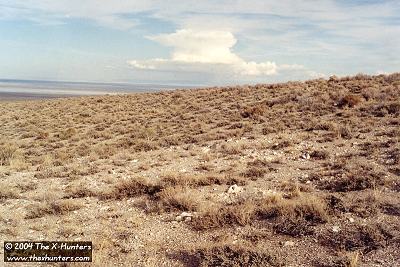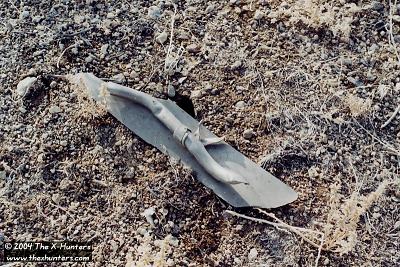
The impact scar at the crash site of Article 123 is barely visible 40 years after the accident.
 The impact scar at the crash site of Article 123 is barely visible 40 years after the accident. |
I contacted Ken Collins and asked him if he remembered where the airplane crashed. He responded by saying that he had been concentrating on making a safe parachute landing at the time and not on marking the location of the wreck relative to any landmarks. He did recall worrying about landing in rugged terrain, which seemed to rule out the salt flats, at least. He had never returned to the site, and so had no additional information for me. Based on what little data I had, I believed the crash site was most likely somewhere between U.S. Highway ALT 93 and the Utah border. Fortunately for me, that would at least put it outside the military boundary, thus making the site more accessible.
Next, I tried to locate someone who might have responded to the accident scene. I called the Wendover Fire Department and was eventually given the name of a retired fireman who had been among those at the scene in 1963. I found him in a rest home in Sandy, Utah. He remembered the incident and thought it might have been near the road to the small Nevada settlement of Blue Lake. As he had recently suffered a stroke, his memory was not as good as it had once been. This was still the best information I had, however, and I planned to put it to the test during a trip to Nevada and Utah in May 1993.
On 4 May, I arrived in the area with Tom Kinzel and Eric LeVeque. We drove to a spot 14 miles due south of Wendover, right on the Nevada-Utah border. It was also located on a dirt road that could be used to get to Blue Lake. Suddenly, the search area didn't look as small as it had on the map. We searched on foot and tried driving several jeep roads, but had no luck. After a few hours, we gave up. It was hardly an intensive effort.
Tom and I returned to the area on 26 May 1995 during another expedition to Utah. We wasted a few hours driving on various dirt roads east and west of Highway ALT 93. Again our search proved fruitless. I resolved to wait to mount another search until I had more information.
In 2001, author Jeannette Remak provided the breakthrough I had been waiting for. She supplied me with a declassified copy of the accident report that she obtained from the CIA while researching the history of the A-12 for a book project. Joe Donoghue, a member of Roadrunners Internationale (the 1129th SAS alumni organization) unearthed additional declassified documents in the National Archives. The reports and memos still gave the location as 14 miles south of Wendover, but provided additional information that narrowed my search area considerably. Based on the new information, I plotted a search grid covering approximately six square miles. This sounds like a small area until it must be searched on foot. All of a sudden, the desert is a vast and lonely place.
According to the accident report, the debris field extended approximately 4,000 feet along a heading of 340 degrees and crossed a ravine. These details gave me hope of finding something despite official assertions that the site had been sanitized. In fact, a formerly secret memorandum to James A. Cunningham, deputy director of the CIA's Office of Special Activities, stated that, "all traces of 123 had been removed from [the] crash scene by late afternoon on 25 May." The writer further asserted that "all small bits and pieces [were] meticulously picked up by hand and carried in boxes back to Wendover." I briefly wondered if this could be true, then dismissed the notion. Experience had taught me that I could pretty much always expect to find debris.
My first opportunity to visit the new search grid came in October 2001 following a Roadrunners reunion in Las Vegas. Ken Collins himself attended the event. I felt fortunate to be admitted as an associate member because of my interest in documenting the OXCART program history. On 5 October, I drove from Las Vegas to Wendover with a brief stop at the crash site of the Lockheed U-2 prototype near Pioche, Nevada. When I reached the A-12 search area, it was late in the afternoon. I spent the few remaining hours of daylight searching the southernmost part of my grid. I walked over low ridges and gullies, but saw no sign of metal or other man-made materials. As the sun set, I drove to Wendover to find a motel room. Upon arrival, I found that one of the tires on my jeep rapidly deflating. Fortunately, I located a service station that could replace it.
 The first piece of A-12 (60-6926/Article 123) found by Peter Merlin on 4 October 2003. |
I revisited the search area once again with Tom Kinzel on 20 May 2003 during our annual road trip through the Southwest. This time, we made a concerted effort to cover a two-square-mile section. After five hours, we had found nothing but a few rusty cans so we moved to a different part of the search grid. Hiking north, we crossed several ridges. Within minutes, I had spotted a twisted piece of metal shining in the late afternoon sun. Certain that I had at long last found the A-12, I rushed forward to claim my prize. Unfortunately, it proved to be aluminum and not titanium as I had hoped. Tom and I soon found ourselves in the middle of a debris field; it was definitely an airplane crash site, but not the one we were looking for. It appeared to be that of a single-engine, propeller-driven airplane dating from World War II and I suspected it must have been lost on a training mission from Wendover Army Air Field. I located part of the control panel with a placard bearing the words RADIO CALL and the tail number 228210. I later identified the wreck as a Republic P-47D that crashed on 5 July 1944. Having run out of time, we departed the area, frustrated but not entirely empty-handed.
Once again, I returned to Wendover, on 3 October 2003, following another Roadrunners reunion in Las Vegas. I was determined to find the A-12 and planned a maximum-effort, blunt-force approach. This time, I started at the P-47 crash site and worked my way east. At one point, I turned around and looked in the direction of the P-47. The debris gleamed in the sun. It looked exactly like I hoped the A-12 debris field would look. As the sun dropped lower, I felt a twinge of frustration. After a few hours, I ran out of daylight entirely and headed into town.
The next morning, about an hour after sunrise, I began an intensive search of the southern and central part of my grid. At first, I was fairly bursting with enthusiasm and energy. As the hours passed, the sun climbed higher. I trudged across the trackless waste and it became an effort to lift my feet. I spotted the unmistakable gleam of metal in a ravine. It was a coffeepot. Later, I saw something shining in the sun. It was the shattered remains of an ornate tea set. Exposed to the sun, the glass had turned a deep purple. There wasn't a road around for miles. I continued on. After eight grueling hours, all I had to show for my efforts was a rusty horseshoe. Maybe it brought me luck.
By now it was late afternoon and the sun was dropping toward the mountains. Dark cumulus clouds were building to the west. I was exhausted and dispirited, but unwilling to give up. I decided to finish off the last part of a section I had mostly covered on previous trips. As I approached my final search area with the setting sun in my eyes, I glanced down and saw a gleaming piece of metal. I stopped to take a look. It was a shard of titanium with a piece of metal tubing attached by a clamp. This was certainly a piece of the A-12. Looking around, I was elated to see that the ground was littered with pieces of titanium and composite material. I was in the middle of the crash site! Adrenaline surged. My search was finally at an end, my tenacity rewarded.
I spotted what appeared to be an impact crater surrounded by metal and composite pieces from the airplane's wings and chines. The ground was hard; it appeared the airplane had not penetrated too deeply into the soil. The debris - just as described in the crash report - had scattered across a ravine. North of the crater, I found turbine blades from the engines, pieces of titanium structure and material from the cockpit. Combing the area eagerly, I found pieces bearing A-12 part numbers and Lockheed "Skunk Works" inspection stamps, several component data plates and part of the interphone control panel. Much of the titanium skin was unpainted, as would be expected on the early A-12 airplanes. Titanium and composite material from the chines was painted black. I found some skin with light gray paint against a natural metal background and some pieces with dark blue paint against light gray. The early A-12 airplanes had U.S. Air Force markings and national insignia painted over light gray backgrounds. Without question, I had found the A-12 crash site. My long search was at an end.
|
|
|
|
|
|
|
|
|